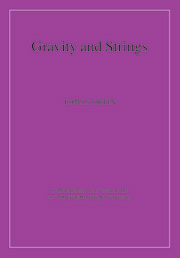Book contents
- Frontmatter
- Contents
- Preface
- Part I Introduction to gravity and supergravity
- 1 Differential geometry
- 2 Noether's theorems
- 3 A perturbative introduction to general relativity
- 4 Action principles for gravity
- 5 N = 1, 2, d = 4 supergravities
- 6 Conserved charges in general relativity
- Part II Gravitating point-particles
- Part III Gravitating extended objects of string theory
- Appendix A Lie groups, symmetric spaces, and Yang–Mills fields
- Appendix B Gamma matrices and spinors
- Appendix C n-Spheres
- Appendix D Palatini's identity
- Appendix E Conformal rescalings
- Appendix F Connections and curvature components
- Appendix G The harmonic operator on ℝ3 × S1
- References
- Index
6 - Conserved charges in general relativity
Published online by Cambridge University Press: 20 February 2010
- Frontmatter
- Contents
- Preface
- Part I Introduction to gravity and supergravity
- 1 Differential geometry
- 2 Noether's theorems
- 3 A perturbative introduction to general relativity
- 4 Action principles for gravity
- 5 N = 1, 2, d = 4 supergravities
- 6 Conserved charges in general relativity
- Part II Gravitating point-particles
- Part III Gravitating extended objects of string theory
- Appendix A Lie groups, symmetric spaces, and Yang–Mills fields
- Appendix B Gamma matrices and spinors
- Appendix C n-Spheres
- Appendix D Palatini's identity
- Appendix E Conformal rescalings
- Appendix F Connections and curvature components
- Appendix G The harmonic operator on ℝ3 × S1
- References
- Index
Summary
The definition of conserved charges in GR (and, in general, in non-Abelian gauge theories) is a very important and rather subtle subject, which is related to the definition of the energy–momentum tensor of the gravitational field. As we saw in the construction of the SRFT of gravity, perturbatively (that is, for asymptotically flat, well-behaved gravitational fields), GR gives a unique energy–momentum (Poincaré) tensor. It is natural to ask whether there is a fully general-covariant energy–momentum tensor for the gravitational field that would reduce to this in the weak-field limit. Many people (starting from Einstein himself) have unsuccessfully tried to find such a tensor, the current point of view being that it does not exist and that we have to content ourselves with energy–momentum pseudotensors for the gravitational field, which are covariant only under a restricted group of coordinate transformations (in most cases, Poincaré's). This, in fact, would be one of the characteristics of the gravitational field tied to the PEGI (see e.g. the discussion in Section 2.7 of [242]) that says that all the physical effects of the gravitational field (and one should include amongst them its energy density) can be locally eliminated by choosing a locally inertial coordinate system.
The most important consequence of the absence of a fully general-covariant energy–momentum tensor for the gravitational field is the non-localizability of the gravitational energy: only the total energy of a spacetime is well defined (and conserved) because the integral of the energy–momentum pseudotensor over a finite volume would be dependent on the choice of coordinates. Some people find this unacceptable and, thus, the search for the general-covariant tensor goes on.
Information
- Type
- Chapter
- Information
- Gravity and Strings , pp. 171 - 184Publisher: Cambridge University PressPrint publication year: 2004
